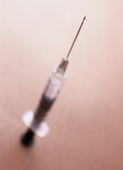- Skip Storing This Everyday Product in the Fridge Door
- Green Tea + B3 Pairing May Boost Brain Health
- Navigating Your Midlife Crisis: Embracing New Possibilities
- City Raccoons Showing Signs of Domestication
- Mapping the Exposome: Science Broadens Focus to Environmental Disease Triggers
- One Week Less on Social Media Linked to Better Mental Health
- Your Brain Changes in Stages as You Age, Study Finds
- Some Suicide Victims Show No Typical Warning Signs, Study Finds
- ByHeart Formula Faces Lawsuits After Babies Sickened With Botulism
- Switch to Vegan Diet Could Cut Your Greenhouse Gas Emissions in Half
HPV Vaccination Tied to Drop in Precancerous Cervical Lesions in U.S.


A new study offers more evidence that the advent of vaccines to fight human papillomavirus (HPV) could reduce cervical cancer in American women.
While it’s still too early to say that vaccines such as Gardasil and Cervarix are lowering cases of cervical cancer, the new study finds a recent decline in the number of young American women with cervical tissue changes that can lead to cancer.
However, researchers led by Susan Hariri of the U.S. Centers for Disease Control and Prevention stressed that another factor may be driving the trend: changes made to cervical cancer screening recommendations in recent years.
“We think that the decreases in high-grade [precancerous] lesions in this group reflect changes in screening but also may be partially due to HPV vaccination,” Hariri said in a news release from the journal Cancer, which published the results of the new study.
According to the researchers, HPV infection causes more than half of high-grade cervical lesions, defined as abnormal tissue that can develop into cancer.
HPV vaccination was introduced in the United States in 2008, and the CDC currently recommends vaccination of girls ages 9 through 12, to help prevent infection with the sexually transmitted virus.
Hariri’s team found that between 2008 and 2012, there was a large decline in high-grade cervical lesions among women ages 18 to 20, and a smaller decrease among women ages 21 to 24.
These lesions do not cause symptoms and can only be detected through cervical cancer screening, Hariri noted.
Recommendations for cervical cancer screening were changed during the study period, so her team also examined trends in the use of screening.
“In particular, screening is no longer recommended in women before age 21 years, and we found substantial declines in screening in 18- to 20-year-olds that were consistent with the new recommendations,” Hariri said.
Screening also fell among women ages 21 to 24, but by a much smaller amount, the researchers said.
Hariri believes that it may take many years to fully assess the impact of HPV vaccination on cervical cancer rates.
Experts who reviewed the study were encouraged, however.
Even though changes in screening complicate things, “due to the dramatic decreases in high-grade lesions in young women, it is felt that there is an impact from vaccination that exceeds the lower rates expected from decreased screening,” said Dr. Jennifer Wu, an obstetrician-gynecologist at Lenox Hill Hospital in New York City.
“HPV vaccination has been shown to decrease the global incidence of precancerous diseases of the cervix,” added Dr. Linus Chuang, professor of obstetrics, gynecology and reproductive science at the Icahn School of Medicine at Mount Sinai in New York City. However, “further study is needed to confirm their findings of the impact of HPV vaccines in U.S. women,” he said.
More information
The U.S. National Cancer Institute has more about cervical changes.
Source: HealthDay
Copyright © 2025 HealthDay. All rights reserved.










